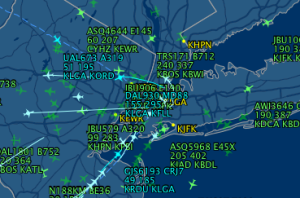Shocker: Having Fewer Air-Traffic Controllers On The Job Results In Flight Delays
Yesterday, furloughs went into effect nationwide for all FAA employees, including air-traffic controllers. As a result of budget cuts, controllers now must take an extra unpaid day off per ever 10 days on the job. The end result is fewer people in the control tower and more planes lined up ready to take off.
As the FAA warned airlines last week, it would need to institute a ground-delay system at a number of the country’s largest airports. This keeps planes at their departing airport until controllers are confident the flight can land without hassle at the destination airport.
It’s only 1 p.m. on the first work day under the furlough system, and the AP reports that flights at some airports are being held for hours on the tarmac before taking off, like the the US Airways flight from Reagan National outside of D.C. to New York City. It pushed back from the gate shortly before 8 a.m., then sat there until 9:48. Nearly two hours on the tarmac for a flight that only lasts fifty minutes in the air.
The 8 a.m. Acela train would have gotten the traveler there faster. And when you factor in the hassle of getting to and from the airport, then through security, driving from D.C. to New York would have been a speedier option.
Even worse, some flights out of Newark heading south have reportedly been turned back around to Newark because controllers monitoring the D.C.-area traffic were too overwhelmed to handle everything flying overhead.
Flightaware.com has this live tracker of delays at airports nationwide.
The worst delays are being seen in New York, where flights are delayed about 100 minutes at both LaGuardia and JFK airports. Baltimore-Washington International is likewise seeing nearly 90-minute delays.
What remains to be seen is whether these problems will persist or if the FAA will be able to hone the ground-delay system so that it doesn’t create such problems. We’ll be keeping an eye on this issue as the busy summer season approaches.
The airlines had asked the FAA to implement the furloughs strategically so that the busier airports would not be hurt by the delays, but the FAA decided to mete out the furloughs uniformly.
On Friday, a group representing the nation’s airlines sued the FAA, asking the court for a 30-day postponement of the furloughs in order to give Congress time to come up with a budgetary solution.
Want more consumer news? Visit our parent organization, Consumer Reports, for the latest on scams, recalls, and other consumer issues.


